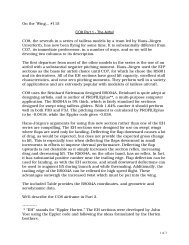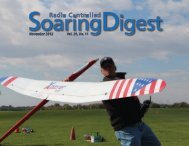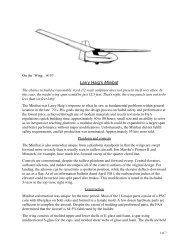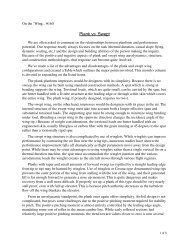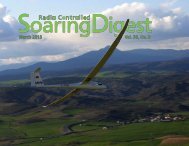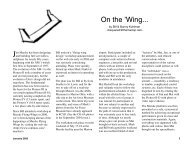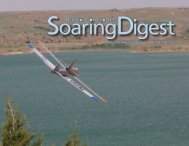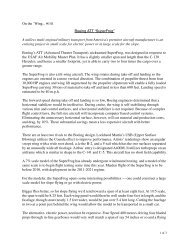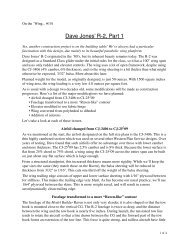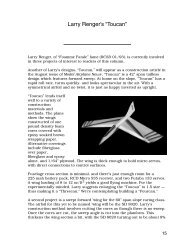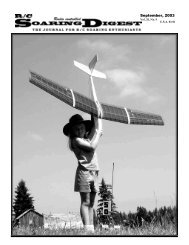Noel Malone's Arrow 60 - Radio Controlled Soaring Digest
Noel Malone's Arrow 60 - Radio Controlled Soaring Digest
Noel Malone's Arrow 60 - Radio Controlled Soaring Digest
You also want an ePaper? Increase the reach of your titles
YUMPU automatically turns print PDFs into web optimized ePapers that Google loves.
On the ’Wing... #159<strong>Noel</strong> Malone’s <strong>Arrow</strong> <strong>60</strong><strong>Noel</strong> Malone’s <strong>Arrow</strong> <strong>60</strong> is designed for slope flying on the sand dunes of Rainbow Beach, acouple hours drive north of Brisbane Australia. This well-designed swept wing tailless modelreceives a lot of positive comments from other Queensland area slope flyers.<strong>Noel</strong> has been working on the <strong>Arrow</strong> <strong>60</strong> project for several years. The model has a relativelysimple planform with an aspect ratio of about nine. It has a <strong>60</strong> inch span and 23 degrees sweep,seven inch constant chord, and winglets. Construction consists of a foam core wing with a carbonspar system and vacuum bagged carbon fiber skins. The fuselage is of molded fiberglass and hasprovision for ballast on the center of gravity. Controls are elevons only and the servos aremounted in the wing.<strong>Arrow</strong> <strong>60</strong> MK 1The Mark 1 version of the <strong>Arrow</strong> <strong>60</strong> served as the test bed for the planform and was constructedseveral years ago.The <strong>Arrow</strong> <strong>60</strong> Mark 1 uses the MH 45 section from root to tip. A carbon fiber spar makes the wingvery stiff. The overall weight for this initial version is less than 20 ounces, 6.8 oz/ft 2 . Even at thislow weight and resulting wing loading, the wing is fairly quick and nimble. A plug-in tail coneallows access for addition of ballast.There were some initial stability problems with this wing, but all difficulties were eventuallytraced to the receiver. The design proved aerodynamically sound and a joy to fly, so it was on toMark 2.<strong>Arrow</strong> <strong>60</strong> MK 2The Mark 2 version wasdesigned to be a bit fasterthan the Mark 1. It uses theMH 64 section and 2.2degrees of twist,computed with the Pankninformula. A more robuststructure increased theweight to 24 ounces, so thewing loading is noticeablyhigher — 8.2 oz/ft 2 .Surprisingly, <strong>Noel</strong> saysthat ballast is required ifthere is reasonable lift.Still, the basic airframecould be made an ounce orso lighter with more careduring construction.1 of 4
2 of 4
JR 331 servos are installed in the wing with direct connections to the elevons. The servos sitagainst the upper carbon skin and lie flush with the lower surface.The Mark 2 <strong>Arrow</strong> <strong>60</strong> is a pleasant aircraft to fly. It’s quite quick and, due to the large elevons, isalso fairly lively, and always attracts a lot of attention on the slope.The Mark 2 version has been flown at Laidley, about an hour west of Brisbane, with theSummerholm Sport Slope Soarers club, as well as at Rainbow Beach. Rainbow Beach is a hugearea with slopes of blown sand.<strong>Noel</strong> added as much ballast as he could, raising the weight to 37 ounces and the wing loading to13.25 oz/ft 2 . The <strong>Arrow</strong> <strong>60</strong> remained very nice to fly at this weight, and was quicker than a coupleof <strong>60</strong>" conventional planes that were at Rainbow Beach.Everyone who has flown the <strong>Arrow</strong> <strong>60</strong> seems to be very impressed with it, especially those whohave previously not been flying wing fans.Two meter versionA two meter version of the <strong>Arrow</strong>, aspect ratio 10, is in the planning stages. This version will bedesigned for slope and flat land thermal flying and will have a three piece wing. Contrary toprevious <strong>Arrow</strong> versions which utilized twist from root to tip, the two meter version willincorporate twist only in the outer <strong>60</strong> percent of the wing.We’re looking forward to being able to follow <strong>Noel</strong>’s future progress on his <strong>Arrow</strong> project.3 of 4
ReferencesCoordinates for the MH 45 and MH 64 are available on Martin Hepperle’s web site.The Panknin formula and associated computer applications are available on the B 2 Streamlinesweb site at .4 of 4



